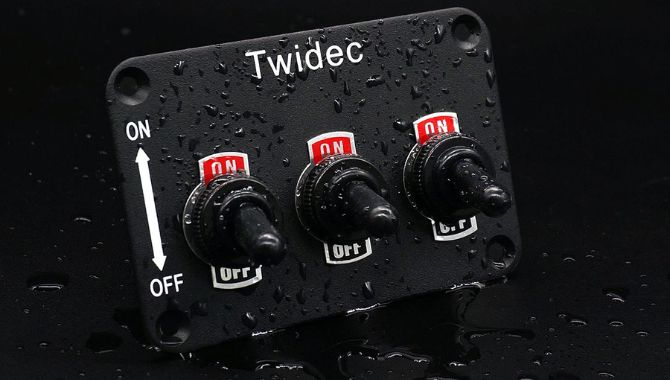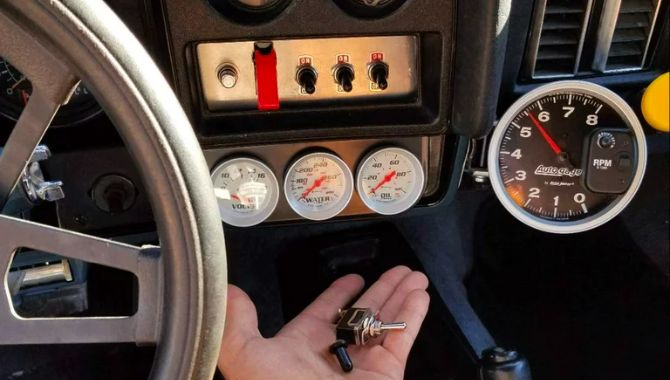
This comprehensive guide delves into the complexities of waterproof toggle switches. We explore their design, features, wiring, and mounting procedures, ensuring a clear understanding of these essential components. Further, we analyze their durability, lifespan, and user-friendly design. Whether for professional or personal use, this guide is an invaluable resource for those seeking to maximize the benefits of these switches. Let’s unravel the intricacies of waterproof toggle switches together.
Ultimate Guide to Waterproof Toggle Switches
- Waterproof toggle switches guideWaterproof Toggle Switch
- Check critical issues
- Remove unnecessary points
- Shorten each line
- Ensure no semantic repetition
Key Takeaways
- Waterproof toggle switches offer durability, weather resistance, and long-lasting performance.
- The installation process for waterproof toggle switches is relatively complex compared to non-waterproof controls, involving securing the button with a washer and nut, connecting terminals, and optionally soldering.
- Waterproof toggle switches have a compact and robust construction, with features like an on/off placard for switch status identification and a silicone waterproof cap for added durability in harsh weather conditions.
- These switches are commonly used in marine, automotive, and industrial settings to control electrical circuits efficiently, ensuring safe operation in various applications.
Understanding Waterproof Toggle Switches
In electrical components, understanding waterproof toggle switches, distinguished by their robust construction and versatility, is fundamental for optimal utilization in various applications. These switches offer several advantages, such as durability, weather resistance, and long-lasting performance, making them particularly suitable for outdoor equipment. However, they also have disadvantages, including a relatively complex installation process compared to non-waterproof alternatives. Installation steps typically involve securing the switch with a washer and nut, connecting the red positive and black negative terminals, and soldering for a more secure connection. Therefore, while the waterproof toggle switch offers critical benefits in specific use cases, it requires careful installation and maintenance to ensure optimal performance.

Key Features and Specifications
Several crucial features and specifications differentiate waterproof toggle switches from their non-waterproof counterparts, making them an ideal choice for various applications. Waterproof toggle switches offer a compact yet robust construction designed for enduring performance. These switches typically come with an easy-to-understand on/off placard, simplifying switch status identification. They also include a silicone waterproof cap for added durability, ensuring the button remains functional even in harsh weather conditions. Moreover, the installation process is straightforward, requiring just a few components like a sliding cover, washer, and nut. With a power rating of 15A 250VAC and 20A 125VAC, these waterproof switches provide reliable performance. Their mechanical and electrical life also surpasses 50,000 and 10,000 cycles, respectively, demonstrating their superior longevity.
Guide to Wiring and Mounting
Transitioning from the key product features, wiring and mounting these waterproof toggle switches warrants further discussion due to their importance in ensuring optimal performance and user safety. Often, color-coded connections can be secured by soldering techniques, providing a robust electrical link. The mounting process relies on specific mounting accessories, including screws and washers, to ensure a secure fit.
| Step | Description | Required Tools |
|---|---|---|
| 1 | Wiring Connections | Soldering Iron, Wire Strippers |
| 2 | Secure Soldering | Solder, Flux |
| 3 | Mounting | Screwdriver, Mounting Accessories |
A proper understanding of wiring and mounting not only guarantees a safe installation but also prolongs the lifespan of the switch, ensuring it operates at its full potential.

Durability and Lifespan Analysis
The durability and lifespan of waterproof toggle switches are critical factors to consider, as they significantly impact the device’s performance and longevity. Mechanical life typically exceeds 50,000 cycles, while electrical energy often surpasses 10,000 cycles. Reliability testing has proven the toughness of the silicone waterproof cap, which screws on tightly to withstand challenging conditions. This enhances the overall durability and extends the lifespan of the switch. A comparison with other switch types reveals that waterproof toggle switches stand out in terms of longevity, mainly due to their weather-resistant features. Therefore, choosing a waterproof toggle switch ensures optimal performance and long-lasting service, making it a worthwhile investment for those seeking to serve others.
User-Friendly Design Considerations
User-friendly design is significant when selecting waterproof toggle switches for various applications. Ergonomics plays a central role in this design, focusing on the interface between the user and the product, promoting comfort, efficiency, and ease of use. A well-designed switch should be easy to grasp and toggle, minimizing user strain. Additionally, clear on/off labels contribute to the switch’s accessibility, reducing the chance of operator error. These features, combined with a compact size and uncomplicated installation process, enhance user-friendliness. Furthermore, a waterproof toggle switch that incorporates these ergonomic and accessibility considerations improves user experience and promotes safe and effective operation, thus serving its users more effectively.
Practical Applications of Switches
In light of the aforementioned user-friendly design considerations, waterproof toggle switches find a wide range of practical applications, including, but not limited to, marine, automotive, and industrial settings. The innovative switch design, characterized by durability and ease of use, facilitates efficient control of electrical circuits in these environments. These switches ensure safe navigation and communication systems operation in marine applications, even under harsh weather conditions. Automotive uses include controlling various vehicle functions, such as lights and wipers. Industrial applications are vast, including machinery control and safety systems. The impact of waterproof switches on outdoor equipment cannot be overstated. They ensure uninterrupted operation, safeguarding both the equipment and the user. These switches underscore the importance of technological innovation in enhancing service delivery.

Maintenance and Troubleshooting Tips
AboutMaintaining and troubleshooting waterproof toggle switches is crucial to follow specific steps to ensure their longevity and optimal performance.
To better serve our audience, we’ve compiled the following technical and detailed list of common problems along with troubleshooting techniques:
- Regularly inspect the waterproof cover for any signs of wear or damage. Replace if necessary.
- Ensure the switch is sealed correctly to prevent water ingress.
- Check for corrosion or dirt build-up on the terminals and clean them with a soft brush.
- Test the switch with a multimeter to confirm it is functioning correctly.
- If experiencing intermittent issues, verify all connections are secure, and wires are not frayed or broken.
You can ensure the reliable operation of your waterproof toggle switches through proper maintenance and troubleshooting.
Frequently Asked Questions
How Do You Clean a Waterproof Toggle Switch Without Damaging It?
Switch maintenance is vital to prolonging the lifespan of a waterproof toggle switch. To clean it, first, ensure the power is disconnected. Use a soft, dry cloth to wipe away dust or dirt. A mild cleaning solution can be applied to the fabric for stubborn grime, not directly on the switch. Be sure to dry thoroughly after cleaning. Regular upkeep ensures optimal performance without damaging the switch’s waterproof feature.
Are These Switches Compatible With All Types of Electrical Devices?
Waterproof toggle switches are highly versatile and compatible with various electrical devices. Their robust construction ensures switch durability, withstanding numerous operational cycles. Advanced waterproofing techniques protect the switch mechanism, making it suitable for multiple environments. However, compatibility also depends on the device’s voltage and current requirements. Hence, checking the switch specifications against the device’s electrical parameters is recommended for optimal performance and safety.
What Safety Measures Should Be Taken During the Installation of These Switches?
When installing waterproof toggle switches, prioritize safety measures. Always turn off the power supply before starting. Use the correct installation tools to avoid damaging the switch’s durability. Ensure tight connections to prevent short circuits. Do not overload the button beyond its power rating. Finally, attach the waterproof cover securely to safeguard the button from moisture or dust. Always double-check your work to ensure a safe, successful installation.
How Do You Replace a Faulty Switch in a Waterproof Toggle Switch Set?
First, disconnect the power to replace a faulty switch in a waterproof toggle switch set. Remove the old button by unscrewing the waterproof cap and disconnecting the wiring. Install the new controller, ensuring proper wiring connections. The longevity of a button dramatically depends on its usage, but typically, it’s above 10,000 cycles. Replacement cost is relatively low but varies depending on the specific model. Always prioritize safety when performing replacements.
Can Waterproof Toggle Switches Be Used in Extremely High or Low Temperatures?
Thanks to their temperature resilience, Waterproof toggle switches can operate in extremely high or low temperatures. The material durability of these switches, including the use of high-quality plastics and metals, ensures reliable performance under varying temperature conditions. However, checking each switch model’s specified operating temperature range is crucial, as excessive temperatures could affect the switch’s functionality and lifespan.
Conclusion
In conclusion, understanding waterproof toggle switches is crucial for various professional applications. This guide has explored their features, wiring and mounting procedures, durability, user-friendliness, and practical uses. Proper maintenance and troubleshooting strategies can further enhance their lifespan and functionality. Hence, acquiring knowledge of these components is paramount for effectively leveraging their benefits. This guide is essential in realizing the full potential of waterproof toggle switches.


